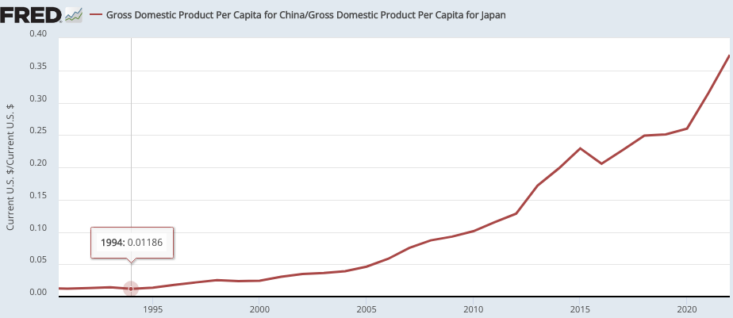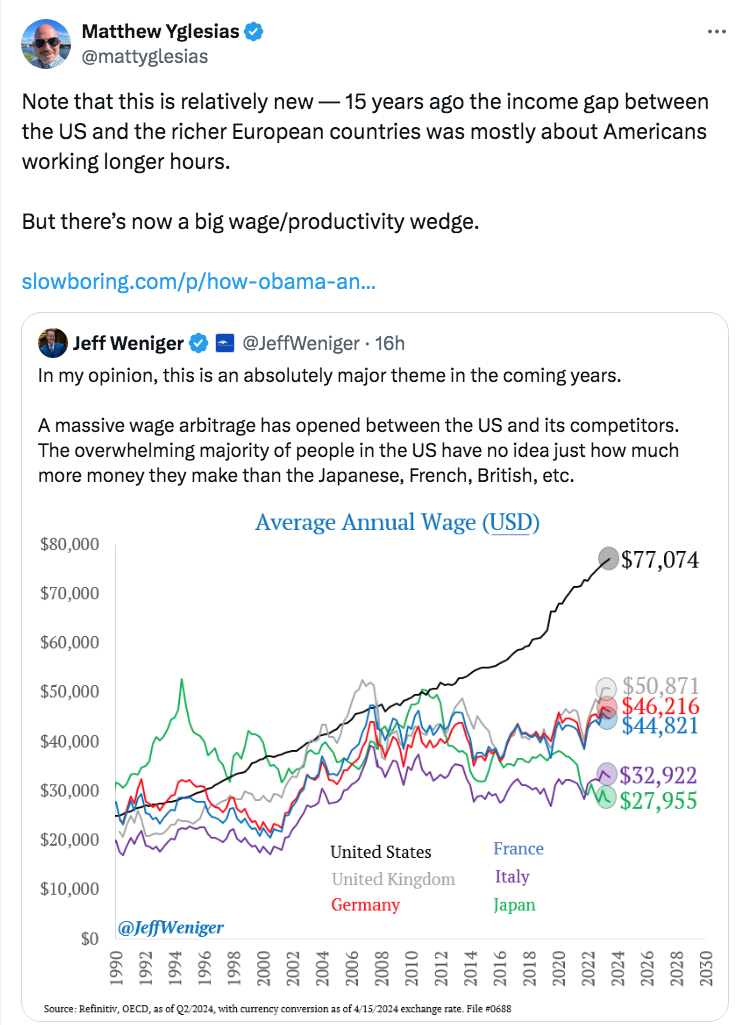
I have frequently argued that China has the world’s largest economy, at least if measured in PPP terms. (Of course in per capita terms they are still only a middle-income country.) Others insist on using market exchange rates, which suggest the US economy is still significantly larger. Fair enough.
But you need to be careful when drawing implications using market exchange rates. They do tell us something about China relative to the US, but they tell us nothing about China in absolute terms. Thus it’s a mistake to look at graphs showing China’s (US dollar) GDP stagnating in recent years and assume that the Chinese economy has stopped converging on developed country status. After all, there is more than one pair of exchange rates. So let’s now do Japan.
The following graph shows the ratio of China’s per capita GDP and Japan’s per capita GDP. In 1994, I got married in Beijing. At the time, China’s per capita GDP was about 1% of Japan’s. That’s really low. By 2022 (the last year shown), it was over 37% of Japan’s and still rising fast. Now it’s close to 40%. So if we really believe that market exchange rates are the right way to think about China’s growth (I don’t), we’d have to conclude that China is rapidly converging on developed country status. Just since 2010, it gone from about 10% to 40% of Japan’s per capita income.

Of course the weak yen overstates China’s advance. But just as the yen is an outlier on the low side, the US dollar is an outlier on the strong side. Most other developed countries have relatively weak currencies when measured against the US dollar, and thus it makes more sense to regard the dollar as unusually strong—we are the outlier.
This leads to some quite misleading graphs if you rely on comparisons using market exchange rates:

Notice that Japanese workers have gone from almost twice as well paid as American workers in the mid-1990s, to just over 1/3 as well paid today. To be clear, I’m on record arguing that the poor performance of the Japanese economy is somewhat real (and not just demographics), but this vastly overstates the problem. The yen has become dramatically weaker, especially in real terms. The Japanese economy is mediocre, but not horrible.
PS. Some have argued that Chinese data is unreliable. But any tourist that visits China (both cities and rural areas), quickly discovers that the country looks significantly richer than suggested by the official per capita GDP (roughly $13,000, vs. $85,000 in the US.) And China is now about 70% urban, so the poor countryside (which is no longer anywhere near so poor as it was) is no longer a plausible explanation. China as a whole is still middle income, but significant portions of China look quite developed. (Shiny new airports, subways, expressways, shopping malls, affluent urban neighborhoods, etc.)

READER COMMENTS
Jose Pablo
Apr 18 2024 at 7:44pm
China as a whole is still middle income, but significant portions of China look quite developed.
The first 40% of “convergence” is the easiest to get, particularly so for a relatively centralized managed economy riding a globalization wave.
For a (relatively) managed economy, the other 60% is much harder to get.
Scott Sumner
Apr 18 2024 at 9:08pm
It’s much easier to get if you are not centrally managed. China began booming when it started decentralizing.
Also keep in mind that China doesn’t have to equal Japan in order to reach developed country status.
Jose Pablo
Apr 18 2024 at 9:51pm
It’s much easier to get if you are not centrally managed.
That’s what I was trying to say. Although on second thought I am not that sure that Japan and Europe (or even the US) are less centralized than China now. Maybe just “centralized differently”
Andrew_FL
Apr 20 2024 at 10:11am
Every country seems richer than it actually is in the tourist areas
Anders
Apr 21 2024 at 9:08am
The US EU wage gap is particularly striking. Especially since a normally uberoptimist US now seems mired in pessimism with alarmist rhetoric about how people struggle to put food on the table near universal, especially on the right, and an almost obligatory preface any time a politician speaks.
Just came back from Japan. Whereas in the 90s, it was well nigh unaffordable (found an apple priced at five usd, more like ten today), I now felt like I paid less than half of what I would in the US for most things, and often less: a basic lunch with noodle soup, salad, and tea can cost three dollars, and a much fancier one about ten. And while the economy overall is stagnant, you do see innovation and vibrancy all over. The puzzle is why such enormous real deflation has not triggered an export driven boom in a country that counts two dozen competitive brands in automotives alone, and even more in electronics. But what I did not notice was discontent and despair anywhere near as palpable as in a us that has the least reason for and culturally lowest predilection for it.
Any ideas?